Before transitioning to a booster seat, use this guide to double-check the requirements, such as age, size, and weight, but also your local laws.
Child passengers must be at least 40 pounds and 57 inches in height before using booster seats. These are the minimum requirements for them to be secured. However, use the following information to safely transition to a booster seat.
This guide will cover:
- Weight Limits of Booster Seats
- At What Age Can My Child Use a Booster Seat?
- Booster Seat Laws in the Us
- Booster Seat Laws in Other Parts of the World
Booster seats don’t have harnesses like car seats. If the passenger is too small, the lap and shoulder seat belt might not fit him properly, risking strangulation and other injuries.
So, no matter your child’s age, your primary considerations when putting him on a booster seat are his weight and height, unless otherwise required by the law.
This article features seven booster seat models from several brands to help you decide if your kid is ready for a booster seat. It covers both high back and backless seats.
You will be presented with a table displaying weight limits and age and height recommendations.
I will also discuss the laws and requirements for using booster seats in some states in the US and other countries.
Weight Limits of Booster Seats
There are two types of booster seats; the high back and backless.
High back booster seats are used if your car has no headrests or has low seatbacks. The opposite applies to backless ones. On top of this, the latter type is usually less expensive.
In general, both types in this table have a minimum weight limit of 40 lbs. (18 kg). Both classes also range from 100 to 120 lbs. (45.5 to 54.5 kg) for the upper limit.
If you need help looking at the figures, the following section discusses the models with more depth.
| Weight Limit | Weight limit (lbs) | Weight limit (kg) | Age limit | Height limit (in) | Height limit (cm) | |||
| Car seats | Min. | Max. | Min. | Max. | Min. | Max. | Max. | Max. |
Graco TurboBooster Highback Booster Seat | 30 | 100 | 13.5 | 45.5 | 3 | 12 | 57 | 144 |
Evenflo Big Kid LX High Back Booster | 40 | 120 | 18 | 54.5 | 5 | 12 | 63 | 160 |
Britax Skyline 2-Stage Belt-Positioning High back booster seat | 40 | 120 | 18 | 54.5 | 5 | 12 | 63 | 160 |
Chicco KidFit 2-in-1 Belt-Positioning High back booster seat | 40 | 110 | 18 | 49.9 | 5 | 12 | 57 | 144 |
Graco TurboBooster LX Backless Booster Car Seat | 40 | 100 | 18 | 45.5 | 5 | 12 | 57 | 144 |
Peg Perego Viaggio Shuttle Backless booster seat | 40 | 120 | 18 | 54.5 | 5 | 12 | 63 | 160 |
Diono Solana 2 Latch Backless booster seat | 40 | 120 | 18 | 54.5 | 5 | 12 | 63 | 160 |
High Back Booster Seats
Here’s more information about the booster seats listed above.
Graco TurboBooster High back Booster Seat
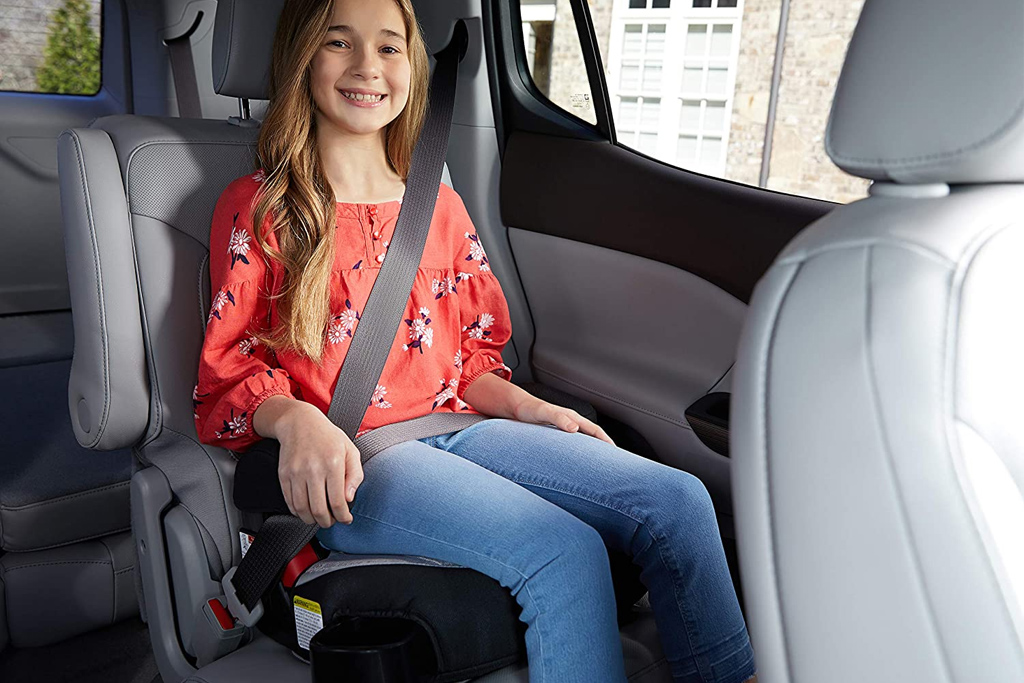
With a minimum weight limit of 30 lbs., Graco recommends this TurboBooster High back Booster Seat to passengers as young as 3. For the upper limit, it’s suitable for a 12-year-old weighing 100 lbs. max. The recommended max height is 57 inches or 4 feet, 9 inches.
This is a 2-in-1 booster that transitions to a backless seat. This means your child can use this model longer. Its headrest is built for comfort. The adjustable armrests and tuck-away cup holders add more convenience.
For all details, check out the Graco TurboBooster on Amazon here!
Evenflo Big Kid LX High Back Booster
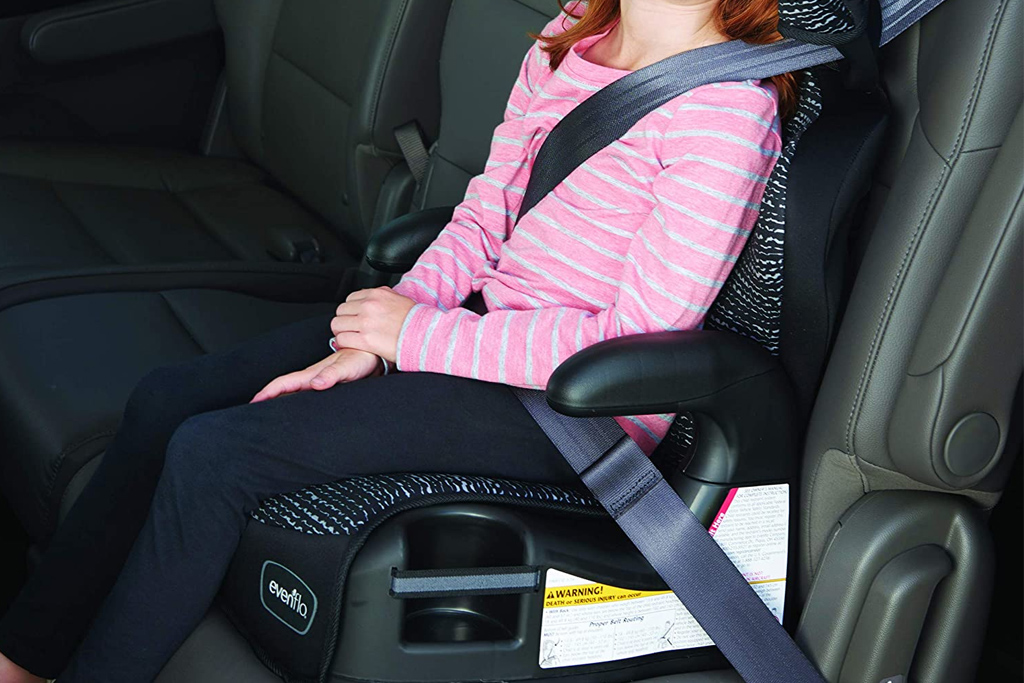
This Evenflo Big Kid LX High Back Booster sticks within the suggested safety limit at 40 lbs. (18 kg) minimum weight limit. At the same time, this booster can support a heavier passenger up to 120 lbs. (54.5 kg). If you have a tall kid, its max height limit of 63 inches is an excellent extension.
Another 2-in-1 model, this booster seat has an adjustable height, accommodating your kid’s growth. Its belt clip ensures proper seatbelt positioning. With two cup holders, you can focus on driving while your kid is having a snack.
For all details, check out the Evenflo Big Kid LX on Amazon here!
Britax Skyline 2-Stage Belt-Positioning Booster Car Seat
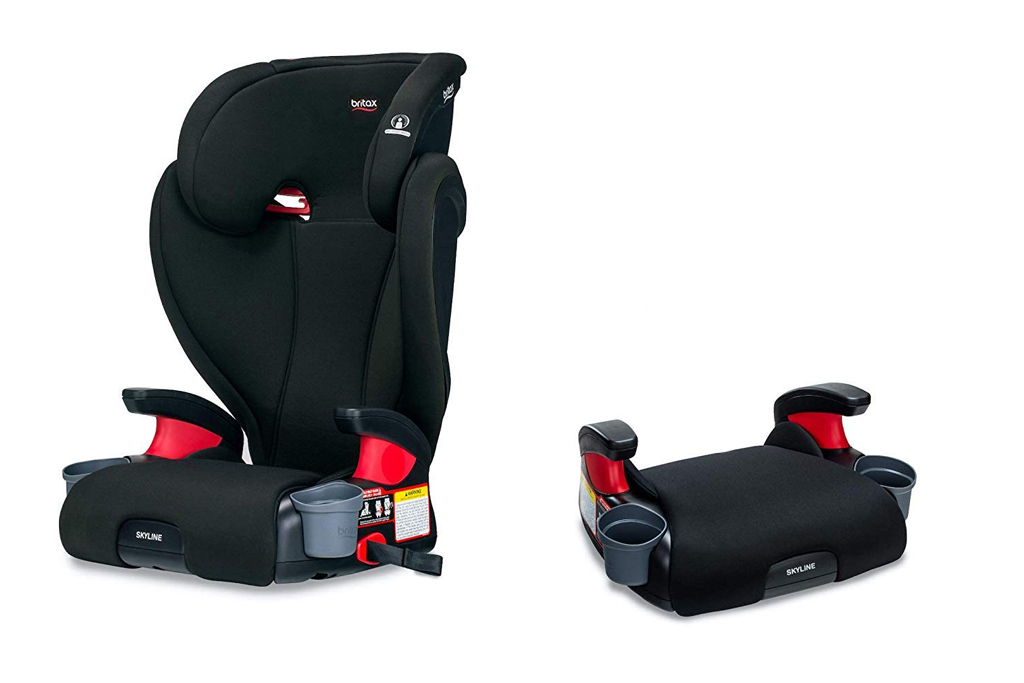
The Britax Skyline 2-Stage Belt-Positioning Booster Car Seat is equipped with all the bells and whistles. This model adheres to safety standards with a minimum weight limit of 40 lbs. And with the upper weight and height limit of 120 lbs and 63 inches, your big girl or boy will be using this for more years.
The backrest offers comfort, while the side-impact protected headrest can save your kid in case of a collision. The belt-positioning adds even more security while your kid rides in the backseat. It’s also equipped with two easy-to-clean cup holders at the base.
For all details, check out the Britax Skyline 2-Stage on Amazon here!
Chicco Kid Fit 2-in-1 Belt-Positioning Booster Car Seat
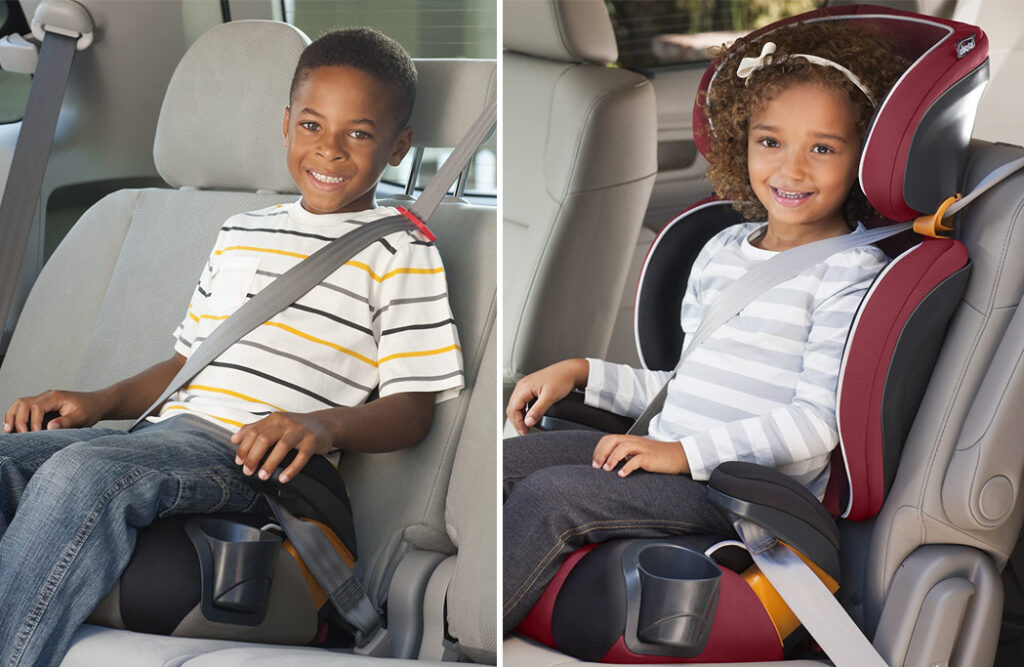
Let your kid ride safely on this Chicco Kid Fit 2-in-1 Belt-Positioning Booster Car Seat as young as 5 or at least 40 lbs. and up to 12 years, weighing 110 lbs max.
Built for safety, comfort, and convenience. This is side-impact protected in multiple positions. Its shaped foam cushions ensure an enjoyable ride without sore backs, even on long journeys.
Easily click the seat into place with the simple latch system. Ensure proper seatbelt position at any age with its belt-positioning clip.
For all details, check out the Chicco KidFit 2-in-1 on Amazon here!
Backless Booster Seats
…and the backless booster seats from the comparison chart.
Graco TurboBooster LX Backless Booster Car Seat
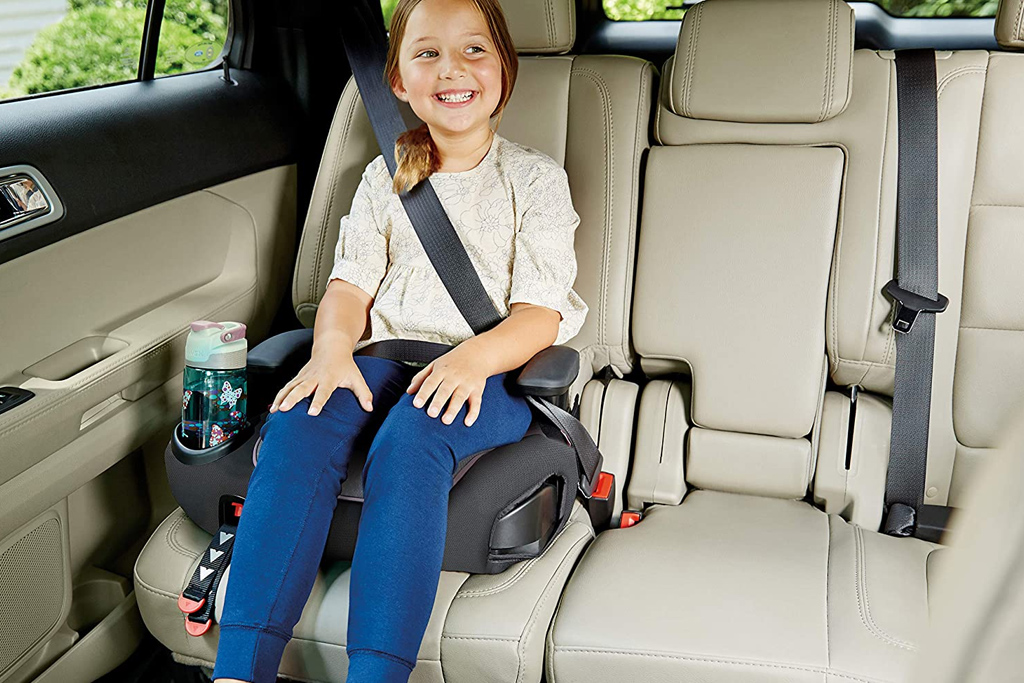
The Graco TurboBooster LX Backless Booster Car Seat is for children 5 to 10 years old, weighing from 40 to 100 lbs. (18 to 45.5 kg) and up to 57 inches tall. This model easily and securely installs with a latch system.
Let your child safely buckle up on her own with the car’s seat belts. Male sure the belt goes over his lap and the middle of his chest. The removable cup holder adds convenience and saves space, while the hide-away storage makes your kid’s stuff accessible.
The machine-washable cushion and easy-to-clean frame make this seat hygienic.
For all details, check out the Graco TurboBooster LX on Amazon here!
Peg Perego Viaggio Shuttle
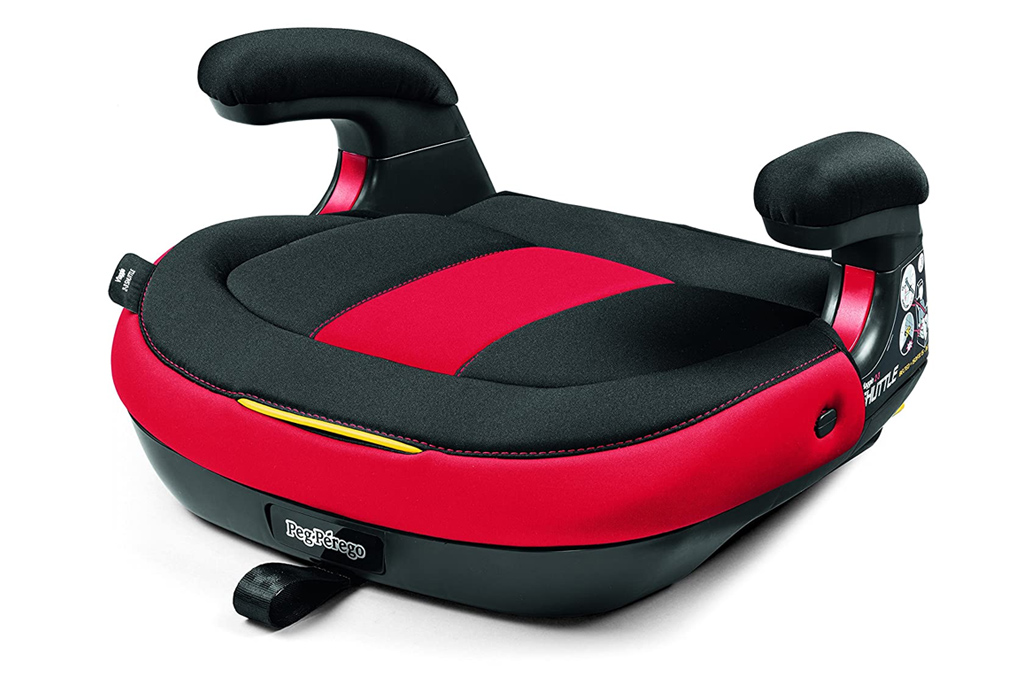
This Peg Perego Viaggio Shuttle booster is compatible with almost all seats, whether with or without latch anchors. Its latch system secures the seat in place, while the Blind Lock System avoids accidental detaching.
Starting with 4 lbs. as weight minimum, your kid will use this for more years with up to 120 lbs capacity and 63 inches height limit.
Bring refreshments within your kid’s reach with the cup holder while the extra soft cushion remains comfortable during long drives.
For all details, check out the Peg Perego Viaggio Shuttle on Amazon here!
Diono Solana 2 Latch
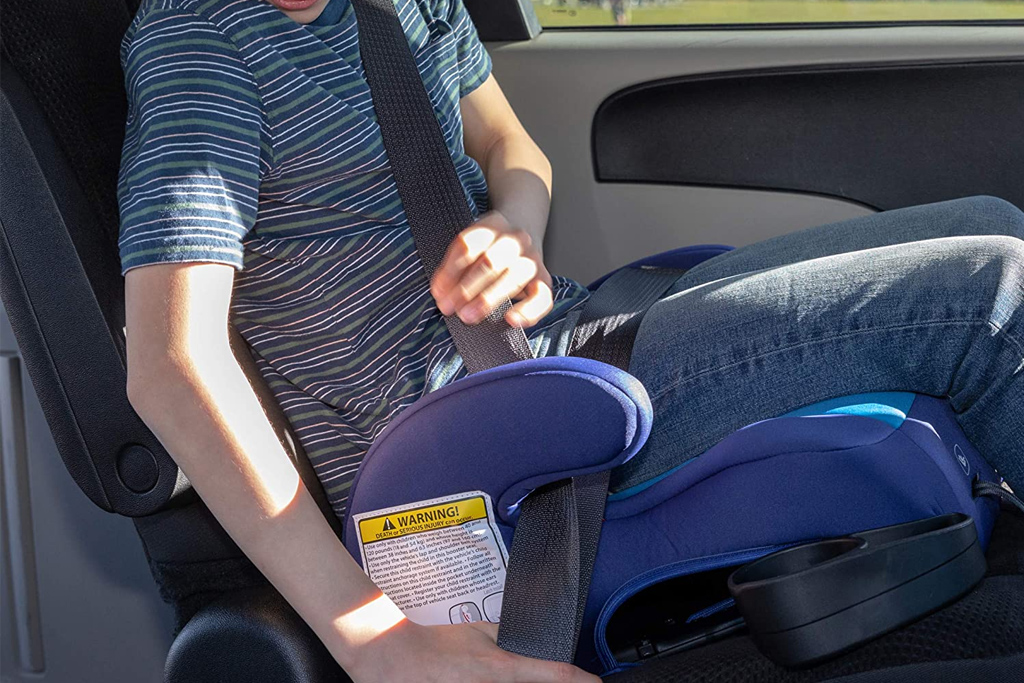
For an extra big kid, this Diono Solana 2 Latch car seat has a minimum to a max weight limit of 40 to 120 lbs and a height recommendation of up to 63 inches. Prevent your kiddo from slipping off with its contoured seat with an extra soft cushion with a machine washable cover.
Weighing only 5.51 lbs., this lightweight booster is easy to transport and install on different seats. It also has space-saving hide-away cup holders.
For all details, check out the Diono Solana 2 on Amazon here!
At What Age Can My Child Use a Booster Seat?
Most booster seat manufacturers present users with minimum age and weight recommendations. However, kids are not always as ready as we expect them to use booster seats.
Other than physical requirements, children must be mentally mature enough to use boosters safely. They must be able to sit still during rides and not lean or slouch while seated.
Booster seats use the car’s seat belt, which may not be safe for a young passenger even if he meets the minimum limit. Seatbelts are easy to unbuckle, making them more of a danger. Meanwhile, both rear-facing and forward-facing car seats are equipped with harnesses built to secure and hold down young passengers. This is why experts suggest letting your kid use car seats for as long as possible before moving on to a booster seat.
Can a 3-year-old go in a booster seat?
Even if the manufacturer recommends a booster seat for a person at this age, 3-year-olds are not old enough for big kid seats. Most kids this age find it hard to sit still. They might also try to experiment with the seatbelt, risking unbuckling during rides.
Experts don’t advise booster seats for kids this young. If your little one still has not outgrown the rear-facing car seat, then it’s best to let him use it longer. Otherwise, opt for a front-facing one.
Can a 4-year-old sit use a booster seat?
Many booster seats start at this age. But toddlers are safest in harnessed car seats. They may not be mature enough to sit still and without messing with the seatbelt at this age.
4-year-olds weigh around 40 lbs. on average. And nowadays, rear-facing car seats support up to 65 lbs. Let your toddler use the car seat for the best, even if some manufacturers recommend their booster seats.
Can a 5-year-old sit in a booster seat?
This is the minimum age recommendation for your child to use a booster seat. If she meets the weight recommendation according to the safety standard, that is 40 lbs.
But still, if she hasn’t outgrown the front-facing car seat, it is best to let her use it.
Can a 6-year-old sit in a booster seat?
By this age, your child will be well within the minimum weight recommendation for booster seats. They are also mature enough to enjoy rides without moving too much. It’s totally okay for her to use the booster seat.
For best comfort and safety, I’d suggest a high back booster seat for your 6-year-old kid. This offers better protection and support. Most kids also fall asleep during rides, so headrests are good to have.
Can my 7-year-old sit in a booster?
Most kids this age still won’t fit the seat belt properly without using booster seats. They must at least be 4 feet 9 inches in height to ride safely without belt-positioning seats. So keep your child secured in a booster seat.
Does a 9-year-old need a booster seat?
Kids are safer in booster seats up until they are around 12 years old or more. This is when they reach 57 inches. At this height, they will fit the seat belts properly.
For your 9-year-old kid, it is most preferable to let her use the booster seat longer. If your booster seat has an option to remove the high back, this might be the right time. If your vehicle’s seat has a seat back reaching behind your kid’s ears and a headrest.
Booster Seat Laws in the Us
Laws regarding child passenger safety and the use of child restraint systems vary from state to state. And due to recent advancements in the car seat and booster seat technology, the requirements may not be the same as a decade or so ago.
As of the writing of this article, these are the rules that I have found. For the best, I suggest you check your local laws in case the requirements get updated.
In general, all states require child restraints systems that are federally approved. That is, you may not use something else to function as a car seat or improvise.
Here’s a list of some of the states and their laws. Check it out below.
Alabama: Booster seats are required by law for kids at 6 years of age. That is, either a backless booster seat or a belt-positioning seat. For younger children, rear-facing car seats are required for up to 1 and weighing at least 20 lbs. Children up to 5 years old or weigh 40 lbs.
Alaska: Kids lower than 57 inches and weighing between 20 to 65 lbs must wear booster seats. This is around the time when children are between 4 to 8 years old. For kids below the age of one and under 20 lbs., rear-facing car seats are required. Kids until 4 should use forward-facing car seats.
Connecticut: From the age of 5 to 8, children must wear child restraints, including boosters. This is the same for those weighing between 40 to 60 lbs. Belt-positioning is also a must. From 2 to 5 years old or 30 to 40 lbs. car seats with 5-point harness are a must for the little ones.
Florida: Child restraints passing federal requirements like car seats and boosters are required for young passengers ages 4 to 5.
Georgia: All children younger than 8 years old should use federally approved child restraint devices. This covers car seats and booster seats, given that these seats are appropriate to your child’s weight and age. Younger passengers below 57 inches must always stay in the backseat.
Hawaii: Booster seats and car seats are required for children between 4 and eight years old. Passengers younger than four must ride in the appropriate safety seat.
Illinois: If you’re from Illinois and have a kid at age 8 or below, you should secure your child in the right restraint system. Any type of safety seat or child restraint device meeting the United States Department of Transportation is acceptable. This includes car seats and booster seats.
Iowa: Closely following manufacturer’s instructions and recommendations, Parents must put their children on car seats or booster seats up to 6 years of age. For infants, rear-facing car seats are required.
Kentucky: Children below 8 years old must, from 40 to 67 inches in height must be secured in either a backless booster seat or belt-positioning seat.
Louisiana: Once your child has outgrown either the weight or height limits of her front-facing car seat, a booster seat should be used to secure her. It should be a belt-positioning booster seat that uses a lap-shoulder belt. Follow the manufacturer’s instructions accordingly. And the only time to stop using the booster seat is around 9 years of age and passing the 5-step fittest for the seat belt.
Maine: Both Ride Safer and booster seats are good child restraint systems. These must be used to secure passengers younger than 8. This also applies to children below 80 lbs and shorter than 4 feet, 9 inches.
Mississippi: For passengers below 7 but older than 4, booster seats or other appropriate child restraint systems are required. This is the same with kids weighing less than 65 lbs and below 57 inches. The vehicle’s safety belt can be used for kids who are at least 80 lbs or more than 57 inches. However, suppose the booster seat’s max limit is still beyond the said requirements. In that case, your kid may continue using the said child restraint system.
Missouri: Same as Mississippi, Missouri law require appropriate child restraints, including booster seats for children between 4 and 8 years of age. If your kid is below 57 inches, this law still applies. Kids at least 80 lbs. or taller than 57 inches may use the car’s seatbelt, but a booster seat may still be used when appropriate.
New Jersey: If your child is younger than 8 and shorter than 57 inches, you may use a booster seat. You can also use a forward-facing car seat with a 5-point harness system to secure your kid. That is, as long as your child has not outgrown the manufacturer’s recommended weight and height limit.
New Mexico: If your kid weighs less than 60 lbs., you must secure her with the appropriate and federally-approved restraint system. This also applies to children from 5 to 6 years old.
New York: A child passenger below 8 years old must use the right child restraint device. The appropriate restraint device is defined as one meeting the child’s weight and height. These are booster seats, car seats, or safety vests.
North Carolina: All child passengers below 8 years old or under 80 lbs must be secured in a car seat or a booster. They may only use the seat belt once they either reach 80 lbs or the age of 8.
Ohio: Children from age 4 to 8 and less than 57 inches tall are required to use booster seats that are federally approved. While for child passengers up to 4 years of age, weighing less than 40 lbs., the appropriate child restraint is required.
Oklahoma: Booster seats and other child restraint systems are a must for passengers 4 to 8 years old. This also applies to children not taller than 4 feet, 9 inches.
Pennsylvania: Passengers younger than 8 but at least 4 years old must be secured in the car with a booster seat of appropriate weight and height capacity. The child restraint system must also meet the federal safety standards. This means improvised car seats and booster seats are not acceptable.
South Carolina: A belt-positioning booster is required for children ages 4 to 8 who are less than 57 inches. These young passengers must be seated at the back at all times.
Texas: If you live in Texas, you must closely follow the car seat or booster seat manufacturer’s weight and height requirements. This is for your kid younger than 8.
Utah: Same with Texas, kids below 8 years old must use a child restraint system. Whether it is a booster seat or a car seat depends on the capacity of the device and the manufacturer’s prescription.
Washington: For kids not taller than 4 feet, 9 inches, they must be secured with a child safety seat. You may use rear-facing, front-facing, or a belt-positioning booster. Whichever is appropriate and with the weight and height capacity to support your child. Only let your kid transition to a seat belt when she properly fits the seat belt. This is around 8 to 12 years of age.
Washington DC: Whichever is appropriate according to the manufacturer’s recommendations, all children below 8 years old must be secured with a rear-facing, forward-facing, convertible, or booster seat. For booster seats, the child must be secured with a lap and shoulder belt.
Wisconsin: If your child is at least 4 years old or younger than 8, she must use a booster seat. This is also true for kids weighing 40 to 80 lbs and is no taller than 4 feet, 9 inches. Use only federally approved child restraints.
Booster Seat Laws in Other Parts of the World
Australia: Child passengers from 4 to 16 years of age may use booster seats or other age, weight, and height appropriate, forward-facing child restraint system.
Mexico: Children ages 4 to 6 must be seated at the back seat and secured in a high back belt-positioning booster seat. A backless booster seat is only appropriate for child passengers ages 6 to 12.
Puerto Rico: Generally, all passengers below 9 must use a child restraint system when in a vehicle. Children must be secured in booster seats from ages 4 to 9 or when shorter than 57 inches. In addition, unless the car has only 1 seat row, passengers below 12 years old must be seated at the back.
Virgin Islands: Booster seats are required for children weighing 40 to 80 lbs or shorter than 57 inches. Passengers ages 13 and below must sit in the back seat at all times.
Takeaway
No matter what type of car seat or booster you’re using to secure your kid, it’s best to let him use it for as long as he doesn’t outgrow the maximum weight and height limit. This ensures that he’s ready for the transition when the time comes.
Each state and country has regulations for child restraints. Make sure you look it up and keep yourself updated. Often, these laws are the minimum safety requirements only. It’s absolutely a good idea to implement a higher safety standard using an appropriate car seat, vest, or booster seat.

